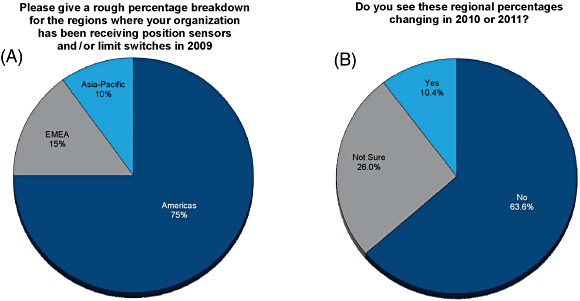Earlier this year, VDC Research Group's Industrial Automation and Control Practice teamed up with Sensors magazine and other Industrial Automation industry partners to conduct a survey on the position sensing market. This survey was in support of a comprehensive three-volume report on position sensing technologies. As most readers know, the past few years have been an unprecedented roller coaster ride from market highs in early 2008 to huge setbacks in 2009 and a bit of an uneven future. The VDC report gives market participants a view of where we have been and where things appear to be going. This article will provide readers with a few selected insights into the linear displacement and rotary (nonmodular) position sensor markets.
First of all, let's take a look at the demographics of the survey participants. Overall, approximately 400 survey participants indicated a role in the selection, purchasing, and/or usage of position sensor products. As we can see in Figure 1, the respondents represented a cross section of business types and industries, and a variety of roles within their companies with the results shown in Figure 2.
 Figure 1. A breakdown of the survey respondents by (A) principal business type and (B) industry served |
 Figure 2. The business roles of (A) survey participants and (B) end users |
One question that the VDC report sought to answer was whether the trend of moving industrial production to the Asia Pacific (APAC) region from Europe, the Middle East, Africa (EMEA), and the Americas had leveled off. To provide user insights into this question, we asked the survey participants to describe the regions from which they were receiving orders for position sensing products (Figure 3). As expected, our survey demographics were slanted towards the Americas, however only 10% of respondents were seeing additional regional shifting of the market. Responses to the follow up question showed that the shifts that were occurring were still toward APAC, however the Americas market was showing signs of stabilization ahead of EMEA. If we look at a 2009 snapshot (Figure 4) of the linear displacement and rotary position markets, we see that they are fairly evenly distributed. As we have noted, the APAC market has been growing faster than both the Americas and EMEA markets.
 Figure 3. Geographic regions (A) from which position sensors are purchased and (B) whether the regional percentages will change over the next year |
 Figure 4. Graph of the market for linear displacement and rotary position sensors showing the regional distribution |
Taking a look at the total market for position sensors (Figure 5) which, in addition to linear (displacement) and rotary (position) also includes limit switches and photoelectric/proximity sensor products, we see that between 2007 and 2008, the market rose at a rate much higher than the ~ 3%–5% rate that had been the rule previously. This was then followed by a 20%–30% drop—depending on sector—with the exception of the military/aerospace market, which had been stabilized by long-term contracts. The position sensor market's current and future state is based as much on economic reality as on consumer perception of whether the apparent recovery is stable in the long term. To assist with the building of the model, VDC uses many sources, including supplier interviews but also the insights of the sensor-user community. Toward this end, several questions attempted to gauge the user's perception of the future as compared to their past (2008) purchase of position sensing products (Figure 6).
 Figure 5. A graph of the total position sensor market (silver line) showing the VDC aggregate model (blue) and military/aerospace markets (green line) |
 Figure 6. User perceptions of future purchase and use of position sensors (Click image for larger version) |
Let's examine a snapshot of two different position sensor products to show more detail on the regions and vertical markets that they are used in. Although this information was mainly based on supply-side analysis, and arrived at based on extensive interviews with sensor manufacturers, the demand-side survey process in which many Sensors readers participated provides context that determines the growth prospects for a given market or sensor product. As a sample we'll look at capacitive linear displacement and the resolver rotary position sensors because they have interesting and contrasting market profiles.
The charts in Figure 7 represent a 2009 snapshot of two significant position sensing markets with the capacitive sensor market predicted to reach $27.3 million in 2013 and the resolver market prediction being approximately $137 million in 2013. The growth/recovery will not be even in all markets and all regions but, at the same time, will be shared across most markets to at least some degree. As most readers probably realize, the position sensor business is complicated, containing many competing technologies vying for the same markets. A given technology has traits that make it superior for one application but problematic for another. The manufacturers that adapt and extend technologies to enter existing markets or enter new ones are destined to be the most successful.
Manufacturers of products that use sensors are always looking for increased durability and lower costs. Recent events involving automotive sensors and the drive to further increase automobile fuel efficiency make the automotive market a prime opportunity for new sensing products capable of addressing the technical and business challenges that will arise as the economy recovers and new environmental requirements are put in place. The new lines of hybrid and pure electric vehicles also offer a significant new frontier for position sensors, particularly those that consume very little power. Inertial sensors will also be likely to be used in applications that have—up until now—been served by older technologies. The position sensing business is in a state of continual flux and we look forward to an interesting future.
About the Author
David A. B. Laing, Senior Analyst/Program Manager – Industrial Automation and Control Practice, can be reached at VDC Research Group, Natick, MA; 508-653-9000, x-146, [email protected].
